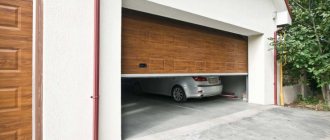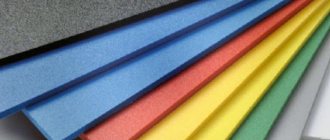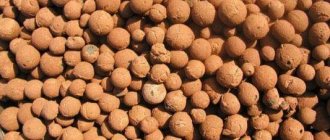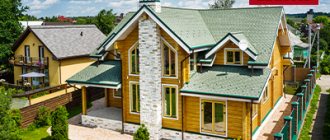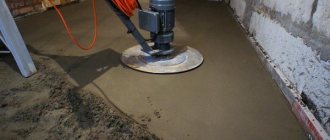In the modern world, an important aspect of a private home is its energy efficiency. That is, the ability to spend a minimum amount of energy to maintain a comfortable climate in the house. To spend less energy, you need to take care of reducing energy losses.
Thermal conductivity of materials is the ability of a material to retain heat in cold weather and keep cool in summer.
Heat capacity is the amount of heat absorbed (released) by a body in the process of heating (cooling) per 1 kelvin.
Density is the ratio of the mass of a body to the volume occupied by this body.
Specific heat capacity of materials
Heat capacity is a physical quantity that describes the ability of a material to accumulate temperature from a heated environment. Quantitatively, specific heat capacity is equal to the amount of energy, measured in J, required to heat a body weighing 1 kg by 1 degree. Below is a table of the specific heat capacity of the most common materials in construction.
In order to calculate the heat capacity of a particular material, you must have the following data:
- type and volume of heated material (V);
- the specific heat capacity of this material (Sud);
- specific gravity (msp);
- initial and final temperatures of the material.
Thermal storage capacity of materials
The heat storage capacity of materials, that is, the ability of a material to retain heat, is estimated by specific heat capacity, i.e. the amount of heat (in kJ) required to raise the temperature of one kilogram of material by one degree. For example, water has a specific heat capacity of 4.19 kJ/(kg*K). This means, for example, that to raise the temperature of 1 kg of water by 1°K, 4.19 kJ is required.
Table 1. Comparison of some heat storage materials
| Material | Density, kg/m 3 | Heat capacity, kJ/(kg*K) | Thermal conductivity coefficient, W/(m*K) | TAM mass for heat accumulation of 1 GJ of heat at Δ= 20 K, kg | Relative mass of TAM in relation to the mass of water, kg/kg | TAM volume for heat accumulation of 1 GJ of heat at Δ= 20 K, m 3 | Relative volume of TAM in relation to the volume of water, m 3 / m 3 |
| Granite, pebbles | 1600 | 0,84 | 0,45 | 59500 | 5 | 49,6* | 4,2 |
| Water | 1000 | 4,2 | 0,6 | 11900 | 1 | 11,9 | 1 |
| Glauber's salt (sodium sulfate decahydrate)* | 14600 t 1300 w | 1.92 t 3.26 f | 1.85 t 1.714 w | 3300 | 0,28 | 2,26 | 0,19 |
| Paraffin* | 786 t | 2.89 t | 0.498 t | 3750 | 0,32 | 4,77 | 0,4 |
Heat capacity of building materials
The heat capacity of materials, the table for which is given above, depends on the density and thermal conductivity of the material.
And the thermal conductivity coefficient, in turn, depends on the size and closedness of the pores. A fine-porous material, which has a closed pore system, has greater thermal insulation and, accordingly, lower thermal conductivity than a large-porous one.
This is very easy to see using the most common materials in construction as an example. The figure below shows how the thermal conductivity coefficient and the thickness of the material influence the thermal insulation qualities of external fences.
The figure shows that building materials with lower density have a lower thermal conductivity coefficient. However, this is not always the case. For example, there are fibrous types of thermal insulation for which the opposite pattern applies: the lower the density of the material, the higher the thermal conductivity coefficient will be.
Therefore, you cannot rely solely on the indicator of the relative density of the material, but it is worth taking into account its other characteristics.
What is thermal conductivity, what units of measurement is it described?
If we do not consider any theoretical conditions, then in reality all physical bodies, liquids or gases have the ability to transfer heat. In other words, to make it clearer, if an object begins to be heated from one side, it becomes a conductor of heat, heating itself and transferring thermal energy further. The same applies to cooling, only with the opposite sign.
Even at a simple everyday level, everyone understands that this ability is expressed in different materials to very different degrees. For example, it is one thing to stir a boiling dish being cooked on the stove with a wooden spatula, and quite another with a metal spoon, which will almost instantly heat up to such a temperature that it will be impossible to hold it in your hands. This example clearly shows that the thermal conductivity of metal is many times higher than that of wood.
A “practical application” of the huge difference in thermal conductivity of materials is a cork slipped under the bracket of a metal pan lid. You can remove such a lid from a pot boiling on the stove with your bare fingers without fear of burns.
And there are a lot of such examples, literally at every step. For example, touch your hand to an ordinary wooden door in a room and to the metal handle screwed on it. It feels like the handle is colder. But this cannot be - all objects in the room have approximately the same temperature. It’s just that the metal of the handle absorbed body heat faster, which caused the feeling of a colder surface.
Thermal conductivity coefficient of the material
Expert opinion: Afanasyev E.V.
Chief editor of the Stroyday.ru project. Engineer.
There is a special unit that characterizes any material as a conductor of heat. It is called the thermal conductivity coefficient, usually denoted by the Greek letter λ , and is measured in W/(m×℃). (In many formulas, instead of degrees Celsius ℃, degrees Kelvin, K , but this does not change the essence).
This coefficient shows the ability of a material to transfer a certain amount of heat over a certain distance per unit of time. Moreover, this indicator characterizes the material itself, that is, without reference to any dimensions.
Such coefficients are calculated for almost any building and other materials. Below in this publication are tables for various groups - mortars, concrete, brick and stone masonry, insulation, wood, metals, etc. Even a quick glance at them is enough to see how different these coefficients can be.
Very often, manufacturers of building materials for one purpose or another indicate the thermal conductivity coefficient in a series of passport characteristics.
Materials that are characterized by high heat conductivity, for example, metals, are often used as heat sinks or heat exchangers. A classic example is heating radiators, in which the better their walls transfer heat from the coolant, the more efficient their operation.
But for most building materials the situation is the opposite. That is, the lower the thermal conductivity coefficient of the material from which the conditional wall is built, the less heat the building will lose with the arrival of cold weather. Or, the smaller the wall thickness can be made with the same thermal conductivity.
Both the title picture for the article and the illustration below show very clear diagrams of how the thickness of a wall made of different materials will differ with equal ability to retain heat in the house. Comments are probably not needed.
The same thermal insulation ability - and completely different thicknesses. A good example is the difference in thermal conductivity.
Reference literature often indicates not one value of the thermal conductivity coefficient for a material, but three. (And sometimes even more, since this coefficient can change with temperature). And this is correct, since the thermal conductivity properties are also affected by operating conditions. And first of all – humidity.
This is typical of most materials - when saturated with moisture, the thermal conductivity coefficient increases. And if the goal is to perform calculations as accurately as possible, with reference to real operating conditions, then it is recommended not to neglect this difference.
So, the coefficient can be given as a calculated one, that is, for completely dry material and laboratory conditions. But for real calculations they take it either for operating mode A or for mode B.
These regimes are consolidated from the climatic characteristics of the region and from the operating characteristics of a particular building (premises).
The type of your climate zone based on humidity level can be determined using the proposed diagram map:
Climatic zones of the territory of Russia according to humidity level: 1 – humid; 2 – normal; 3 – dry.
Features of the humidity conditions of the premises are determined according to the following table:
Table for determining the humidity conditions of rooms
| Room humidity conditions | Relative humidity of indoor air at temperature: | ||
| up to 12°С | from 13 to 24°C | 25°C and above | |
| Dry | up to 60% | up to 50% | up to 40% |
| Normal | from 61 to 75% | from 51 to 60% | from 41 to 50% |
| Wet | 76% or more | from 61 to 75% | from 51 to 60% |
| Wet | — | 76% or more | 61% or more |
Speaking of humidity!..
Do you have a good idea of what relative air humidity is? And what should it be like in rooms to maintain a comfortable microclimate? If this is not clear, welcome to a special publication on our portal dedicated to instruments for measuring relative humidity .
So, having the data from the schematic map and table, you can use the second table to decide on the choice of mode A or B , on which the actual value of the thermal conductivity coefficient will depend.
Table for selecting the operating mode of enclosing structures
| Humidity conditions of the room (according to the table) | Humidity zones (in accordance with the diagram map) | ||
| 3 - dry | 2 - normal | 1 - wet | |
| Dry | A | A | B |
| Normal | A | B | B |
| Damp or Wet | B | B | B |
It is in this mode that the thermal conductivity coefficient closest to reality is selected from the tabular data.
The tables will be given below, under the theoretical part.
Heat transfer resistance
Expert opinion: Afanasyev E.V.
Chief editor of the Stroyday.ru project. Engineer.
So, the thermal conductivity coefficient characterizes the material itself. But from a practical point of view, it is probably more important to have some kind of value that will describe the thermal conductivity of a particular structure. That is, taking into account the features of its structure and size.
There is such a unit of measurement, and it is called heat transfer resistance. It can be considered the reciprocal of the thermal conductivity coefficient, while taking into account the thickness of the material.
Heat transfer resistance (or, as it is often called, thermal resistance) is denoted by the Latin letter R. If you “dance” from the thermal conductivity coefficient, then it is determined by the following formula.
R = h/ λ
Where:
R —heat transfer resistance of a single-layer homogeneous enclosing structure, m²×℃/W;
h is the thickness of this layer, expressed in meters;
λ is the thermal conductivity coefficient of the material from which this enclosing structure is made, W/(m×℃).
Multilayer structures are often used in construction. Including one of the layers is often an insulating material with a very low thermal conductivity coefficient - specifically to maximize the value of thermal resistance. The fact is that the total value is summed up from the resistances of all layers that make up the enclosing structure. And to them is added the resistance of the border layers of air on the external and internal surfaces of the structure.
The formula for the resistance of a partition with n-layers will be as follows:
Rsum = R₁ + R₂ + …+Rn + Rai + Rao
Where:
Rsum is the total thermal resistance of the enclosing structure;
R₁ … Rn – layer resistances, from 1 to n;
Rai is the resistance of the wall layer of air inside;
Rao is the resistance of the wall air layer outside.
For each layer, the resistance is calculated separately, based on the thermal conductivity of the material and thickness.
There is a special method for calculating the coefficients of air gaps along the wall outside and inside. But for simplified calculations, they can be taken to be equal to a total of 0.16 m²×℃/W - there will not be a large error.
By the way, if the design of the partition includes an air cavity that does not communicate with the outside air, then it also provides a significant addition to the overall heat transfer resistance. The heat transfer resistance values of insulated air layers are shown in the table below:
Table of thermal resistances of closed air layers
| Air gap thickness, meters | B and D ▲ | G▼ | ||
| tв > 0 ℃ | tв | tв > 0 ℃ | tв | |
| 0.01 | 0.13 | 0.15 | 0.14 | 0.15 |
| 0.02 | 0.14 | 0.15 | 0.15 | 0.19 |
| 0.03 | 0.14 | 0.16 | 0.16 | 0.21 |
| 0.05 | 0.14 | 0.17 | 0.17 | 0.22 |
| 0.1 | 0.15 | 0.18 | 0.18 | 0.23 |
| 0.15 | 0.15 | 0.18 | 0.19 | 0.24 |
| 0,2-0,3 | 0.15 | 0.19 | 0.19 | 0.24 |
| Notes: | ||||
| B and D ▲ - vertical or horizontal air gap, with heat spreading from bottom to top | ||||
| G▼ - horizontal air gap when heat spreads from top to bottom | ||||
| tв > 0 ℃ - positive air temperature in the interlayer | ||||
| tв | ||||
| If any of the surfaces of the air gap, or both at the same time, are covered with aluminum foil, then the value of heat transfer resistance is taken to be twice as large. | ||||
Tables of thermal conductivity coefficients of various groups of building materials
Table of thermal conductivity coefficients of brickwork and stone wall cladding
| Name of material | ρ Average material density kg/m³ | λ₀ Thermal conductivity coefficient in ideal conditions and in a dry state W/(m×℃) | λA Thermal conductivity coefficient for operating conditions A W/(m×℃) | λB Thermal conductivity coefficient for operating conditions B W/(m×℃) |
| Brickwork made of solid bricks using various mortars | ||||
| Standard ceramic (clay) - on cement-sand masonry mortar | 1800 | 0,56 | 0,70 | 0,81 |
| Standard ceramic based on cement-slag mortar | 1700 | 0,52 | 0,64 | 0,76 |
| Standard ceramic with cement-perlite mortar | 1600 | 0,47 | 0,58 | 0,70 |
| Silicate on cement-sand masonry mortar | 1800 | 0,70 | 0,76 | 0,87 |
| Trepelny thermal insulation, on cement-sand masonry mortar | 1200 | 0,35 | 0,47 | 0,52 |
| - the same, but with density | 1000 | 0,29 | 0,41 | 0,47 |
| Slag, on cement-sand masonry mortar | 1500 | 0,52 | 0,64 | 0,70 |
| Hollow brick masonry | ||||
| Ceramic brick, with a density of 1400 kg/m³, on cement-sand mortar | 1600 | 0,47 | 0,58 | 0,64 |
| - the same, but with a brick density of 1300 kg/m³ | 1400 | 0,41 | 0,52 | 0,58 |
| - the same, but with a brick density of 1000 kg/m³ | 1200 | 0,35 | 0,47 | 0,52 |
| Silicate brick, eleven-hollow, on cement-sand masonry mortar | 1500 | 0,64 | 0,70 | 0,81 |
| - the same, fourteen-hollow | 1400 | 0,52 | 0,64 | 0,76 |
| Masonry or surface cladding with natural stone | ||||
| Granite or basalt | 2800 | 3,49 | 3,49 | 3,49 |
| Marble | 2800 | 2,91 | 2,91 | 2,91 |
| Tuff | 2000 | 0,76 | 0,93 | 1,05 |
| - the same, but with density | 1800 | 0,56 | 0,70 | 0,81 |
| - the same, but with density | 1600 | 0,41 | 0,52 | 0,64 |
| - the same, but with density | 1400 | 0,33 | 0,43 | 0,52 |
| - the same, but with density | 1200 | 0,27 | 0,35 | 0,41 |
| - the same, but with density | 1000 | 0,21 | 0,24 | 0,29 |
| Limestone | 2000 | 0,93 | 1,16 | 1,28 |
| - the same, but with density | 1800 | 0,70 | 0,93 | 1,05 |
| - the same, but with density | 1600 | 0,58 | 0,73 | 0,81 |
| - the same, but with density | 1400 | 0,49 | 0,56 | 0,58 |
Table of thermal conductivity coefficients of concrete of various types
| Name of material | ρ kg/m³ | λ₀ W/(m×℃) | λA W/(m×℃) | λB W/(m×℃) |
| Dense aggregate concrete | ||||
| Reinforced concrete | 2500 | 1.69 | 1.92 | 2.04 |
| Concrete on natural gravel or crushed stone | 2400 | 1.51 | 1.74 | 1.86 |
| Concrete on natural porous aggregates | ||||
| Pumice concrete | 1600 | 0.52 | 0.6 | 0.68 |
| - the same, but with density | 1400 | 0.42 | 0.49 | 0.54 |
| - the same, but with density | 1200 | 0.34 | 0.4 | 0.43 |
| - the same, but with density | 1000 | 0.26 | 0.3 | 0.34 |
| - the same, but with density | 800 | 0.19 | 0.22 | 0.26 |
| Tufobeton | 1800 | 0.64 | 0.87 | 0.99 |
| - the same, but with density | 1600 | 0.52 | 0.7 | 0.81 |
| - the same, but with density | 1400 | 0.41 | 0.52 | 0.58 |
| - the same, but with density | 1200 | 0.29 | 0.41 | 0.47 |
| Concrete on volcanic slag | 1600 | 0.52 | 0.64 | 0.7 |
| - the same, but with density | 1400 | 0.41 | 0.52 | 0.58 |
| - the same, but with density | 1200 | 0.33 | 0.41 | 0.47 |
| - the same, but with density | 1000 | 0.24 | 0.29 | 0.35 |
| - the same, but with density | 800 | 20 | 0.23 | 0.29 |
| Concrete on artificial porous fillers | ||||
| Expanded clay concrete on quartz sand with porosity | 1200 | 0.41 | 0.52 | 0.58 |
| - the same, but with density | 1000 | 0.33 | 0.41 | 0.47 |
| - the same, but with density | 800 | 0.23 | 0.29 | 0.35 |
| Expanded clay concrete on expanded clay sand or expanded clay foam concrete | 1800 | 66 | 0.8 | 0.92 |
| - the same, but with density | 1600 | 0.58 | 0.67 | 0.79 |
| - the same, but with density | 1400 | 0.47 | 0.56 | 0.65 |
| - the same, but with density | 1200 | 0.36 | 0.44 | 0.52 |
| - the same, but with density | 1000 | 0.27 | 0.33 | 0.41 |
| - the same, but with density | 800 | 0.21 | 0.24 | 0.31 |
| - the same, but with density | 600 | 0.16 | 0.2 | 0.26 |
| - the same, but with density | 500 | 0.14 | 0.17 | 0.23 |
| Expanded clay concrete on perlite sand | 1000 | 0.28 | 0.35 | 0.41 |
| - the same, but with density | 800 | 0.22 | 0.29 | 0.35 |
| Perlite concrete | 1200 | 0.29 | 0.44 | 0.5 |
| - the same, but with density | 1000 | 0.22 | 0.33 | 0.38 |
| - the same, but with density | 800 | 0.16 | 0.27 | 0.33 |
| - the same, but with density | 600 | 0.12 | 0.19 | 0.23 |
| Slag pumice concrete | 1800 | 0.52 | 0.63 | 0.76 |
| - the same, but with density | 1600 | 0.41 | 0.52 | 0.63 |
| - the same, but with density | 1400 | 0.35 | 0.44 | 0.52 |
| - the same, but with density | 1200 | 0.29 | 0.37 | 0.44 |
| - the same, but with density | 1000 | 0.23 | 0.31 | 0.37 |
| Slag pumice foam and slag pumice gas concrete | 1600 | 0.47 | 0.63 | 0.7 |
| - the same, but with density | 1400 | 0.35 | 0.52 | 0.58 |
| - the same, but with density | 1200 | 0.29 | 0.41 | 0.47 |
| - the same, but with density | 1000 | 0.23 | 0.35 | 0.41 |
| - the same, but with density | 800 | 0.17 | 0.29 | 0.35 |
| Vermiculite concrete | 800 | 0.21 | 0.23 | 0.26 |
| - the same, but with density | 600 | 0.14 | 0.16 | 0.17 |
| - the same, but with density | 400 | 0.09 | 0.11 | 0.13 |
| - the same, but with density | 300 | 0.08 | 0.09 | 0.11 |
| Cellular concrete | ||||
| Aerated concrete, foam concrete, gas silicate, foam silicate | 1000 | 0.29 | 0.41 | 0.47 |
| - the same, but with density | 800 | 0.21 | 0.33 | 0.37 |
| - the same, but with density | 600 | 0.14 | 0.22 | 0.26 |
| - the same, but with density | 400 | 0.11 | 0.14 | 0.15 |
| - the same, but with density | 300 | 0.08 | 0.11 | 0.13 |
| Gas ash concrete, foam ash concrete | 1200 | 0.29 | 0.52 | 0.58 |
| - the same, but with density | 1000 | 0.23 | 0.44 | 0.59 |
| - the same, but with density | 800 | 0.17 | 0.35 | 0.41 |
Table of thermal conductivity coefficients of mortars based on cement, lime, and gypsum
| Name of material | ρ kg/m³ | λ₀ W/(m×℃) | λA W/(m×℃) | λB W/(m×℃) |
| Ordinary cement-sand mortar | 1800 | 0.58 | 0.76 | 0.93 |
| Complex mortar of cement, sand, lime | 1700 | 0.52 | 0.7 | 0.87 |
| Cement-slag mortar | 1400 | 0.41 | 0.52 | 0.64 |
| Cement-perlite mortar | 1000 | 0.21 | 0.26 | 0.3 |
| - the same, but with density | 800 | 0.16 | 0.21 | 0.26 |
| Lime-sand mortar | 1600 | 0.47 | 0.7 | 0.81 |
| - the same, but with density | 1200 | 0.35 | 0.47 | 0.58 |
| Gypsum-perlite solution | 600 | 0.14 | 0.19 | 0.23 |
| Gypsum-perlite porous mortar | 500 | 0.12 | 0.15 | 0.19 |
| - the same, but with density | 400 | 0.09 | 0.13 | 0.15 |
| Cast structural gypsum boards | 1200 | 0.35 | 0.41 | 0.47 |
| - the same, but with density | 1000 | 0.23 | 0.29 | 0.35 |
| Plasterboard sheets (dry plaster) | 800 | 0.15 | 0.19 | 0.21 |
Table of thermal conductivity coefficients of wood, wood-based products, and other natural materials
| Name of material | ρ kg/m³ | λ₀ W/(m×℃) | λA W/(m×℃) | λB W/(m×℃) |
| Coniferous wood (pine or spruce) across the grain | 500 | 0,09 | 0,14 | 0,18 |
| - they are along the fibers | 500 | 0,18 | 0,29 | 0,35 |
| Dense hardwood (oak, beech, ash) across the grain | 700 | 0,1 | 0,18 | 0,23 |
| - they are along the fibers | 700 | 0,23 | 0,35 | 0,41 |
| Plywood | 600 | 0,12 | 0,15 | 0,18 |
| Lined cardboard | 1000 | 0,18 | 0,21 | 0,23 |
| Multilayer construction cardboard | 650 | 0,13 | 0,15 | 0,18 |
| Fiberboards (Fiberboard), chipboards (chipboards), oriented strand boards (OSB) | 1000 | 0,15 | 0,23 | 0,29 |
| - the same, but for density | 800 | 0,13 | 0,19 | 0,23 |
| - the same, but for density | 600 | 0,11 | 0,13 | 0,16 |
| - the same, but for density | 400 | 0,08 | 0,11 | 0,13 |
| - the same, but for density | 200 | 0,06 | 0,07 | 0,08 |
| Fiberboard slabs, wood concrete based on Portland cement | 800 | 0,16 | 0,24 | 0,3 |
| - the same, but for density | 600 | 0,12 | 0,18 | 0,23 |
| - the same, but for density | 400 | 0,08 | 0,13 | 0,16 |
| - the same, but for density | 300 | 0,07 | 0,11 | 0,14 |
| Reed slabs | 300 | 0,07 | 0,09 | 0,14 |
| - the same, but for density | 200 | 0,06 | 0,07 | 0,09 |
| Peat thermal insulation slabs | 300 | 0,064 | 0,07 | 0,08 |
| - the same, but for density | 200 | 0,052 | 0,06 | 0,064 |
| Construction tow | 150 | 0,05 | 0,06 | 0,07 |
Table of thermal conductivity coefficients of materials used for thermal insulation purposes
| Name of material | ρ kg/m³ | λ₀ W/(m×℃) | λA W/(m×℃) | λB W/(m×℃) |
| Mineral wool, glass wool | ||||
| Mineral wool mats, pierced or with a synthetic binder | 125 | 0.056 | 0.064 | 0.07 |
| - the same, but for density | 75 | 0.052 | 0.06 | 0.064 |
| - the same, but for density | 50 | 0.048 | 0.052 | 0.06 |
| Mineral wool slabs with synthetic and bitumen binders - soft, semi-rigid and hard | 350 | 0.091 | 0.09 | 0.11 |
| - the same, but for density | 300 | 0.084 | 0.087 | 0.09 |
| - the same, but for density | 200 | 0.07 | 0.076 | 0.08 |
| - the same, but for density | 100 | 0.056 | 0.06 | 0.07 |
| - the same, but for density | 50 | 0.048 | 0.052 | 0.06 |
| Mineral wool slabs with an organophosphate binder - increased rigidity | 200 | 0.064 | 0.07 | 0.076 |
| Glass staple fiber boards with synthetic binder | 50 | 0.056 | 0.06 | 0.064 |
| Stitched glass fiber mats and strips | 150 | 0.061 | 0.064 | 0.07 |
| Synthetic insulation | ||||
| Expanded polystyrene | 150 | 0.05 | 0.052 | 0.06 |
| - the same, but for density | 100 | 0.041 | 0.041 | 0.052 |
| - the same, but for density | 40 | 0.038 | 0.041 | 0.05 |
| Foam plastic PVC-1 and PV-1 | 125 | 0.052 | 0.06 | 0.064 |
| - the same, but for density | 100 or less | 0.041 | 0.05 | 0.052 |
| Polyurethane foam slab | 80 | 0.041 | 0.05 | 0.05 |
| - the same, but for density | 60 | 0.035 | 0.041 | 0.041 |
| - the same, but for density | 40 | 0.029 | 0.04 | 0.04 |
| Sprayed polyurethane foam | 35 | 0.027 | 0.033 | 0.035 |
| Resol-formaldehyde foam boards | 100 | 0.047 | 0.052 | 0.076 |
| - the same, but for density | 75 | 0.043 | 0.05 | 0.07 |
| - the same, but for density | 50 | 0.041 | 0.05 | 0.064 |
| - the same, but for density | 40 | 0.038 | 0.041 | 0.06 |
| Polyethylene foam | 30 | 0.03 | 0.032 | 0.035 |
| Polyisocyanurate (PIR) boards | 35 | 0.024 | 0.028 | 0.031 |
| Perlitoplast-concrete | 200 | 0.041 | 0.052 | 0.06 |
| - the same, but for density | 100 | 0.035 | 0.041 | 0.05 |
| Perlite phosphogel products | 300 | 0.076 | 0.08 | 0.12 |
| - the same, but for density | 200 | 0.064 | 0.07 | 0.09 |
| Foamed rubber | 85 | 0.035 | 0.04 | 0.045 |
| Natural based insulation | ||||
| Ecowool | 60 | 0.041 | 0.054 | 0.062 |
| - the same, but for density | 45 | 0.038 | 0.05 | 0.055 |
| - the same, but for density | 35 | 0.035 | 0.042 | 0.045 |
| Technical plug | 50 | 0.037 | 0.043 | 0.048 |
| Cork sheets | 220 | 0.035 | 0.041 | 0.045 |
| Thermal insulating flax slabs | 250 | 0.054 | 0.062 | 0.071 |
| Construction wool felt | 300 | 0.057 | 0.065 | 0.072 |
| - the same, but for density | 150 | 0.045 | 0.051 | 0.059 |
| Wood sawdust | 400 | 0.092 | 1.05 | 1.12 |
| - the same, but for density | 200 | 0.071 | 0.078 | 0.085 |
| Mineral backfills | ||||
| Expanded clay - gravel | 800 | 0.18 | 0.21 | 0.23 |
| - the same, but for density | 600 | 0.14 | 0.17 | 0.2 |
| - the same, but for density | 400 | 0.12 | 0.13 | 0.14 |
| - the same, but for density | 300 | 0.108 | 0.12 | 0.13 |
| - the same, but for density | 200 | 0.099 | 0.11 | 0.12 |
| Shungizite - gravel | 800 | 0.16 | 0.2 | 0.23 |
| - the same, but for density | 600 | 0.13 | 0.16 | 0.2 |
| - the same, but for density | 400 | 0.11 | 0.13 | 0.14 |
| Crushed stone from blast furnace slag, slag pumice and agloperite | 800 | 0.18 | 0.21 | 0.26 |
| - the same, but for density | 600 | 0.15 | 0.18 | 0.21 |
| - the same, but for density | 400 | 1.122 | 0.14 | 0.16 |
| Crushed stone and sand from expanded perlite | 600 | 0.11 | 0.111 | 0.12 |
| - the same, but for density | 400 | 0.076 | 0.087 | 0.09 |
| - the same, but for density | 200 | 0.064 | 0.076 | 0.08 |
| Vermiculite expanded | 200 | 0.076 | 0.09 | 0.11 |
| - the same, but for density | 100 | 0.064 | 0.076 | 0.08 |
| Dry construction sand | 1600 | 0.35 | 0.47 | 0.58 |
| Foam glass or gas glass | ||||
| Foam glass or gas glass | 400 | 0.11 | 0.12 | 0.14 |
| - the same, but for density | 300 | 0.09 | 0.11 | 0.12 |
| - the same, but for density | 200 | 0.07 | 0.08 | 0.09 |
Table of thermal conductivity coefficients of roofing, waterproofing, cladding, roll and self-leveling floor coverings
| Name of material | ρ kg/m³ | λ₀ W/(m×℃) | λA W/(m×℃) | λB W/(m×℃) |
| Asbestos-cement | ||||
| Flat asbestos-cement sheets (“flat slate”) | 1800 | 0.35 | 0.47 | 0.52 |
| - the same, but for density | 1600 | 0.23 | 0.35 | 0.41 |
| Bitumen based | ||||
| Petroleum bitumens for construction and roofing | 1400 | 0.27 | 0.27 | 0.27 |
| - the same, but for density | 1200 | 0.22 | 0.22 | 0.22 |
| - the same, but for density | 1000 | 0.17 | 0.17 | 0.17 |
| Asphalt concrete | 2100 | 1.05 | 1.05 | 1.05 |
| Products made from expanded perlite with a bitumen binder | 400 | 0.111 | 0.12 | 0.13 |
| - the same, but for density | 300 | 0.067 | 0.09 | 0.099 |
| Ruberoid, glassine, roofing felt, flexible tiles | 600 | 0.17 | 0.17 | 0.17 |
| Linoleums and self-leveling polymer floors | ||||
| Polyvinyl chloride multilayer linoleum | 1800 | 0.38 | 0.38 | 0.38 |
| - the same, but for density | 1600 | 0.33 | 0.33 | 0.33 |
| Polyvinyl chloride linoleum on a fabric base | 1800 | 0.35 | 0.35 | 0.35 |
| - the same, but for density | 1600 | 0.29 | 0.29 | 0.29 |
| - the same, but for density | 1400 | 0.23 | 0.23 | 0.23 |
| Self-leveling polyurethane floor | 1500 | 0.32 | 0.32 | 0.32 |
| Self-leveling epoxy floor | 1450 | 0.029 | 0.029 | 0.029 |
Table of thermal conductivity coefficients of metals and glass
| Name of material | ρ kg/m³ | λ₀ W/(m×℃) | λA W/(m×℃) | λB W/(m×℃) |
| Steel, including reinforcing bars | 7850 | 58 | 58 | 58 |
| Cast iron | 7200 | 50 | 50 | 50 |
| Aluminum | 2600 | 221 | 221 | 221 |
| Copper | 8500 | 407 | 407 | 407 |
| Bronze | 7500÷9300 | 25÷105 | 25÷105 | 25÷105 |
| Brass | 8100÷8800 | 70÷120 | 70÷120 | 70÷120 |
| Quartz window glass | 2500 | 0.76 | 0.76 | 0.76 |
Nowadays, mainly synthetic materials are used to insulate various buildings. They have excellent characteristics and, for the most part, are very easy to install.
Based on the values in the tables above, one of the most energy-efficient synthetic insulation materials is the PIR board. With a density of only 35 kg/m³, its thermal conductivity coefficient averages 0.024 W/m*K. But it may be less depending on the PIR board production technology of a particular manufacturer.
Comparison of thermal conductivity of PIR boards and other materials
For example, LOGICPIR PIR boards from the Russian manufacturer TECHNONICOL have a thermal conductivity of only 0.022 W/m*K. Why does the value drop so much? The fact is that this type of insulation has a foil layer on both sides. Foil, as you know, is itself capable of perfectly reflecting thermal energy in the opposite direction, that is, into the room. Thanks to this property, the energy efficiency of the material increases, and heat loss in the house is reduced. Thus, PIR insulation, which has such a layer on one side and the other, performs its functions much better than, for example, PIR material with a paper technological coating.
In general, LOGICPIR is a regular PIR board, which is a porous material with many microcells filled with air. It is very thin (thickness varies between 2-5 cm), lightweight, does not load building structures, but is strong and dense enough to withstand some physical impacts. Inert to chemical influences, biologically stable and, in addition, not prone to fire.
TECHNONICOL PIR board
During operation (and the service life of LOGICPIR PIR boards is 50 years), the material does not lose its properties. Its thermal conductivity coefficient does not change even when wet: the insulation itself does not absorb water. Additional vapor protection is provided by the same foil layer - if, when installing the slabs, all joints are glued with aluminum tape, then a continuous layer of vapor barrier is formed that does not allow moisture to pass through. In a word, this is a good option for synthetic insulation with some of the highest characteristics.
Video: Insulation of a frame house with PIR plates
Comparative characteristics of the heat capacity of basic building materials
In order to compare the heat capacity of the most popular building materials, such as wood, brick and concrete, it is necessary to calculate the heat capacity for each of them.
First of all, you need to decide on the specific gravity of wood, brick and concrete. It is known that 1 m3 of wood weighs 500 kg, brick - 1700 kg, and concrete - 2300 kg. If we take a wall whose thickness is 35 cm, then through simple calculations we find that the specific gravity of 1 square meter of wood will be 175 kg, brick - 595 kg, and concrete - 805 kg. Next, we will select the temperature value at which thermal energy will accumulate in the walls. For example, this will happen on a hot summer day with an air temperature of 270C. For the selected conditions, we calculate the heat capacity of the selected materials:
- Wall made of wood: C=SudhmuddhΔT; Sder=2.3x175x27=10867.5 (kJ);
- Concrete wall: C=SudhmuddhΔT; Cbet = 0.84x805x27 = 18257.4 (kJ);
- Brick wall: C=SudhmuddhΔT; Skirp = 0.88x595x27 = 14137.2 (kJ).
From the calculations made, it is clear that with the same wall thickness, concrete has the highest heat capacity, and wood has the least. What does this mean? This suggests that on a hot summer day, the maximum amount of heat will accumulate in a house made of concrete, and the least amount of heat will accumulate in a house made of concrete.
This explains the fact that in a wooden house it is cool in hot weather and warm in cold weather. Brick and concrete easily accumulate a fairly large amount of heat from the environment, but just as easily part with it.
Heat capacity and thermal conductivity of materials
Thermal conductivity is a physical quantity of materials that describes the ability of temperature to penetrate from one wall surface to another.
To create comfortable indoor conditions, it is necessary that the walls have a high heat capacity and a low thermal conductivity coefficient. In this case, the walls of the house will be able to accumulate thermal energy from the environment, but at the same time prevent the penetration of thermal radiation into the room.
